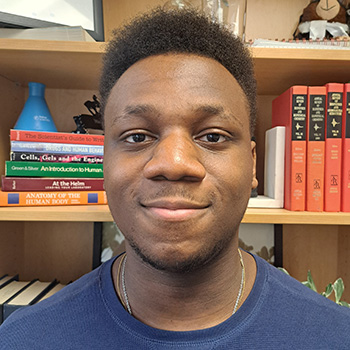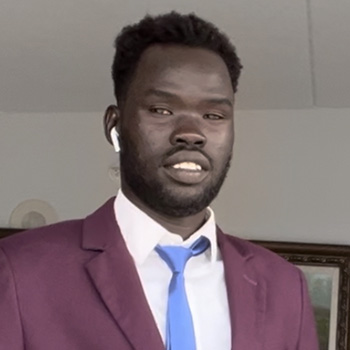We use cookies on this site to enhance your experience.
By selecting “Accept” and continuing to use this website, you consent to the use of cookies.
Search for academic programs, residence, tours and events and more.
Feb. 5, 2024
Print | PDFFunded by the Natural Sciences and Engineering Research Council of Canada, the Undergraduate Student Research Award (USRA) program enables talented, hardworking students to learn from mentors in their respective STEM fields and help cultivate new research. During 16-week internships, students earn real-world work experience and potentially kickstart a path toward future graduate studies.
In recognition of Black History Month, Wilfrid Laurier University is highlighting the stories of three students who participated in the USRA program in 2023. These students worked alongside Laurier faculty members to investigate existing ideas and formulate novel solutions to global problems. Below, they describe their experiences and the positive impacts they hope to make through their research.
 Nikaela Walker is a fourth-year Biology student studying anatomy, physiology and chemistry. Through the USRA program, she had the opportunity to research plant immune responses with Danve Castroverde, an assistant professor in Laurier’s Biology department.
Nikaela Walker is a fourth-year Biology student studying anatomy, physiology and chemistry. Through the USRA program, she had the opportunity to research plant immune responses with Danve Castroverde, an assistant professor in Laurier’s Biology department.
“The allure of this research lies in its intersectionality with climate change, a topic that I find both compelling and alarming,” says Walker.
In Castroverde’s lab, Walker studied the effects of heightened temperatures on the molecular immunity of certain plants. Her key objective was to help develop climate-resistant plants to mitigate the adverse effects of climate change on global food supplies.
Walker cites the support of her friends and family – specifically her sister, Natassja – as being “pivotal” in shaping her academic journey. She hopes her research experience will inspire other Black students to pursue excellence and “strive toward a career in science, medicine or any of the STEM fields.”
After graduation, Walker hopes to earn a Master of Science degree and attend dental school.
 Jordan Meikle is in the first year of his Master of Health Sciences degree at Laurier. During his time as an undergraduate student, Meikle began working with Nirosha Murugan, a Faculty of Science Distinguished Research Chair, and contributed to the development of a neuroimaging tool that can identify early brain changes associated with cancer-related cognitive impairment.
Jordan Meikle is in the first year of his Master of Health Sciences degree at Laurier. During his time as an undergraduate student, Meikle began working with Nirosha Murugan, a Faculty of Science Distinguished Research Chair, and contributed to the development of a neuroimaging tool that can identify early brain changes associated with cancer-related cognitive impairment.
“Although life-saving, cancer treatment can be life-altering, leading to a decline in quality of life,” says Meikle.
All cells continuously release low-intensity emissions of light. Murugan believes that these light-based biomarkers can be used to detect cancer in its early stages, as well as predict cognitive impairment before the onset of symptoms.
“I hope that, through our research, we can gain further insight and understanding of how biophotons relate to neural activity,” says Meikle. “With the new tool, I hope that we can provide earlier, more accurate assessments of brain changes associated with cancer – and even beyond.”
Meikle continues to work in Murugan’s lab during his master’s program and expects to keep studying the relationship between biophotons and human health by eventually obtaining his PhD.
 Lorecha Lobulo is a third-year BSc Honours Chemistry student. His research centres on making new organic molecules called ligands that will provide fundamental scientific insights about intermolecular interactions. This knowledge can potentially be applied to environmental sensing, a field that measures environmental factors such as temperature, humidity and air quality.
Lorecha Lobulo is a third-year BSc Honours Chemistry student. His research centres on making new organic molecules called ligands that will provide fundamental scientific insights about intermolecular interactions. This knowledge can potentially be applied to environmental sensing, a field that measures environmental factors such as temperature, humidity and air quality.
With support from the USRA program, Lobulo worked alongside Louise Dawe, associate professor of Chemistry and Biochemistry, and other Laurier students to explore the structure and properties of these new organic molecules with specific ions: metal cations and anions.
“This is such a fascinating area of research because it’s a colourful chemistry field,” says Lobulo. “Most of the compounds that we made exhibited different colours due to different electronic transitions within the metal-ligand complex.”
These colours are a visual cue to researchers that their targeted interactions are taking place. Colour changes can serve as a signal when trying to detect if a desirable or undesirable substance is present in the surroundings.
“My main research objective was to grow crystals from these colourful reactions,” says Lobulo. “We can then use the crystals to create models of what is taking place at the molecular level. This is fundamental to understanding and maybe later to applications.”
Next summer, Lobulo wishes to further explore this area of chemistry and crystallography to study the 3D structures of molecules. In the future, he hopes to combine his lab work with computational chemistry methods to better understand the interactions that he has observed and predict new molecules capable of even better outcomes.